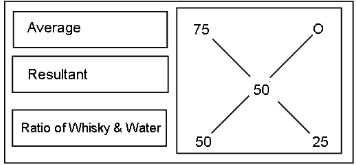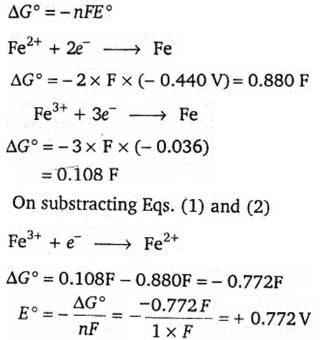GATE Life Science Mock Test - 4 (Biochemistry & Micro Biology) - GATE Life Sciences MCQ
30 Questions MCQ Test GATE Life Sciences 2026 Mock Test Series - GATE Life Science Mock Test - 4 (Biochemistry & Micro Biology)
She observed me for a long ______________.
Choose the term that completes the analogy:
Cover : Uncover :: Associate : ____
Cover : Uncover :: Associate : ____
Due to flooding, kharif (summer sown) crops across various regions of the country have suffered damage. Officials are optimistic that the production losses from the kharif crops can be compensated by the yields from the rabi (winter sown) crops, enabling the country to meet its food-grain production goal of 291 million tons for the crop year 2019-20 (July-June). They express hope that substantial rainfall in July-August will aid in retaining soil moisture for an extended period, benefiting winter sown crops like wheat and pulses during the November-February timeframe.
Which of the following conclusions can be drawn from the passage provided?
Which of the following conclusions can be drawn from the passage provided?
An opaque cylinder (depicted below) is positioned in the path of a parallel light beam, resulting in its shadow being projected onto a screen that is aligned perpendicular to the direction of the light. The cylinder can be rotated in any direction within the beam of light. Given these circumstances, which of the shadows P, Q, R, and S is NOT achievable?

A whisky bottle holds 3/4th whisky, with the remainder being water. What volume of this mixture needs to be removed and replaced with the same volume of water in order to achieve a mixture of half whisky and half water?
In 2015, the fiscal deficit constituted 4% of the GDP, which increased to 5% in 2016. Given that the GDP rose by 10% from 2015 to 2016, what is the percentage increase in the actual fiscal deficit?
A tank can be filled by two pipes, P and Q, in 6 hours and 9 hours, respectively, while another pipe, R, can empty the tank in 12 hours. Initially, pipes P and R are opened together for 4 hours. After this, pipe P is turned off, and pipe Q is turned on. Following 6 additional hours, pipe R is turned off. What is the total time taken to completely fill the tank (in hours)?
A solution in water comprises a combination of 10-8 M NaCl and 10-8 M HCl.
Select the accurate statement regarding this solution.
In naphthalene, what is the value of the integer “n” as per Huckel’s rule of aromaticity? __
Which of the following substances is most likely to undergo dehydration when exposed to acidic conditions?
Considering the provided standard electrode potentials:
Fe2 2e– → Fe Eo = -0.440V
Fe3 3e– → Fe Eo = -0.036V
What is the standard electrode potential (Eo) for the reaction Fe3 e– → Fe2 ?
Identify the reactants X and Y in the given reaction.
Which of the following statements regarding the diborane molecule is inaccurate?
Direction: Analyze the reaction represented by the following equation:
CH3Cl(g) H2O(g) → CH3OH(g) HCl(g)
The kinetic data related to the concentrations for this reaction have been collected as shown below.

If H2O is used in a large excess, what would be the order of this reaction?
Eº = 1.10 V for the following cell reaction:

For this reaction, the equilibrium constant is y × 1037 at 298 K. The value of y is _____ (rounded off to two decimal places).
(Given: F = 96485 C molˉ1, R = 8.314 J K ˉ1 molˉ1)
Instructions: For the Assertion (A) and Reason (R) given below, select the appropriate option.
Assertion: The initial phase of transposition involves the creation of a strand transfer complex where the transposon is linked to the target site via one strand on each end.
Reason: Replicative Transposition occurs through a Cointegrate.
In the case of delayed hypersensitivity, when do the typical lesions manifest?
Identify the enzymes that possess proteolytic activity from the options listed below.
The enzyme that is lacking in Tay-Sachs disease is _____.
The following steps associated with the Variable Number of Tandem Repeats (VNTR) technique are outlined:
(i) Extraction of DNA
(ii) Electrophoretic separation of DNA fragments
(iii) Cleavage of DNA using restriction endonucleases
(iv) Hybridization with a labeled VNTR probe
(v) Blotting separated DNA fragments onto synthetic membranes like nitrocellulose or nylon
(vi) Visualization of hybridized DNA fragments through autoradiography
The initial and terminal steps are positioned accurately. Which of the following sequences for steps (ii) to (v) is correct?
Select the accurate set of statements regarding the MHC II protein from the options below.
A. It consists of 1, 2, 1 and 2 domains.
B. The 1 and 1 are polymorphic domains.
C. It plays a role in presenting antigens to cytotoxic T-cells.
D. Only the chain is glycosylated.
What factor(s) contribute to a reduction in activation energy?
The enzyme glyceraldehyde-3-phosphate dehydrogenase, which plays a role in the glycolytic pathway, was altered using iodoacetic acid, leading to a decrease in enzymatic activity. This alteration occurs as a result of changes to the active site residue.
Examine the following assertions.
A. The hormones that influence the expression of the PEPCK gene include insulin, thyroid hormone, glucagon, and glucocorticoids.
B. The glucocorticoid receptor belongs to a superfamily of cytosolic receptors.
C. The glucocorticoid receptor is part of the superfamily of nuclear receptors.
D. The glucocorticoid response element lacks a palindromic sequence.
Which of the following assertions are accurate?
Mac Conkey's agar is __________.
Transitioning a culture of Saccharomyces cerevisiae from a fermentative to an aerobic respiratory state will
A volume of 250 μl of bacteriophage stock, which has a concentration of 8 x 108 phages/ml, is mixed with 500 μl of E. coli culture that contains 4 x 108 cells/ml. Calculate the multiplicity of infection.
What is the process through which organic carbon is generated?
Chaetomium atrobrunneum is a mold with dark pigmentation that belongs to the fungal division Ascomycota. Which of the following statements about this mold is incorrect?
In cases of tetanus, the toxin tetanospasmin functions by inhibiting




 of the mixture with water.
of the mixture with water. in acidic condition gives stable conjugated alkene.
in acidic condition gives stable conjugated alkene.

















